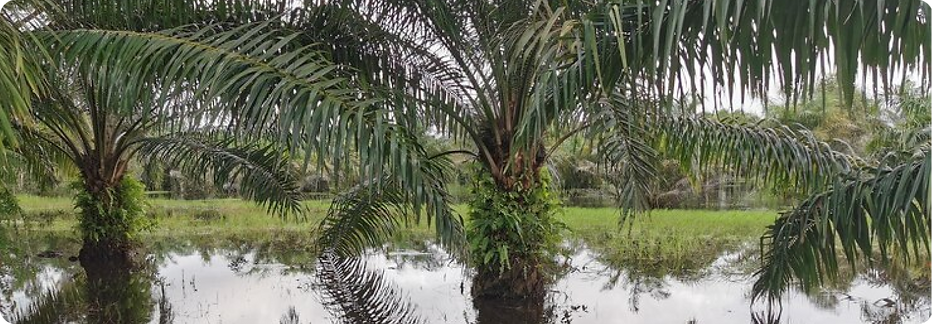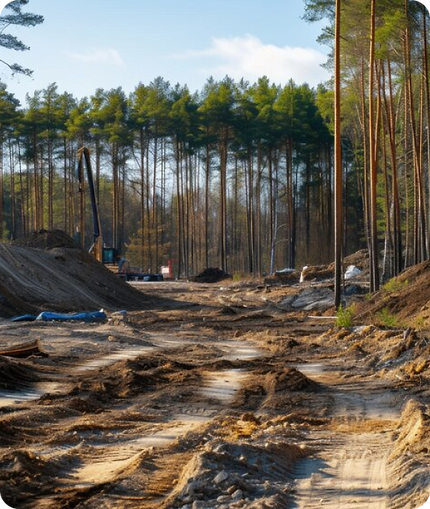top of page


The Environmental Implications of Palm Oil Production and Consumption
.png)
Introduction
Palm oil, derived from the fruit of the oil palm tree, is a key ingredient in many consumer products, ranging from food and cosmetics to biofuels. While it offers significant economic benefits, its production poses serious environmental challenges. This article explores these environmental impacts, focusing on deforestation, biodiversity loss, greenhouse gas emissions, and socio-economic effects.
.png)
The Scale of Production
Indonesia and Malaysia dominate global palm oil production, contributing over 85% of the total output. In 2023, global production reached approximately 79,464 thousand metric tons. This high yield at a relatively low cost makes palm oil economically attractive compared to other vegetable oils. However, the environmental costs of such large-scale production are substantial.
.png)
Deforestation and Habitat Loss
The expansion of palm oil plantations often involves clearing vast areas of tropical rainforests. This deforestation leads to significant habitat loss for numerous species, including endangered ones like orangutans, Sumatran tigers, and Bornean pygmy elephants. The loss of these biodiverse habitats not only threatens wildlife but also disrupts entire ecosystems.
.png)
Greenhouse Gas Emissions
The conversion of forests and peatlands to palm oil plantations releases significant amounts of carbon dioxide and other greenhouse gases. Peatlands, which are rich in carbon, store vast amounts of carbon that, when drained and burned, contribute substantially to global carbon emissions. This process exacerbates climate change and undermines efforts to reduce global greenhouse gas emissions.
.png)
Soil and Water Degradation
Palm oil plantations can lead to soil erosion and degradation, affecting soil fertility and health. The use of fertilizers and pesticides contaminates water sources, impacting aquatic life and local communities who rely on these waters for their daily needs. The intensive monoculture farming practices associated with palm oil can deplete the soil of essential nutrients, furthering environmental harm.
.png)
Socio-Economic Impacts
While palm oil production provides employment and economic benefits to many developing regions, it also poses socio-economic challenges. Land conflicts, displacement of indigenous communities, and poor working conditions are prevalent issues in the industry. These human rights concerns highlight the need for sustainable and equitable production practices.
.png)
Shifts in Consumption Patterns
The European Union, previously a major consumer of palm oil, has significantly reduced its consumption, from 6.6 million metric tons annually between 2015 and 2020 to 5 million metric tons in 2021. This reduction reflects a growing awareness of the environmental and ethical issues associated with palm oil and a commitment to more sustainable consumption practices.
The Environmental Impact of Palm Oil
.png)
Deforestation and Wildlife Endangerment
The booming demand for palm oil has driven extensive deforestation in some of the world’s most biodiverse regions, particularly in Sumatra and Borneo. This habitat destruction has dire consequences for endangered species, including orangutans, pygmy elephants, and Sumatran rhinos. In Indonesia, a forest area the size of Belgium disappears every two years due to palm oil cultivation.
Orangutans, in particular, face severe threats. Between 1999 and 2015, nearly 150,000 orangutans were killed in Borneo. Their population has plummeted by 80% in the last 75 years, leaving around 104,000 individuals. Without substantial conservation efforts, another 45,000 could be lost by 2050 due to ongoing habitat destruction.
Contribution to CO2 Emissions
Clearing land for palm oil plantations involves logging and burning, releasing significant amounts of CO2. Tropical deforestation accounts for approximately 18% of global greenhouse gas emissions, with palm oil plantations contributing 10% to permanent global cropland.
Human Rights Violations
The palm oil industry is infamous for labor abuses, including forced and child labor. Children are often employed to carry heavy loads, weed fields, and collect fruit for minimal wages. Additionally, the industry's expansion has led to numerous conflicts in Indonesia, involving thousands of communities in disputes over land and resources.
The Ubiquity of Palm Oil
Palm oil is a staple in the global market, found in roughly half of all packaged supermarket products. Its high yield and cost-effectiveness make it a preferred choice over other vegetable oils. Palm oil's versatility means it’s used in everything from food products to personal care items, making it challenging to avoid.
Negative Impact of Palm Oil in Sumatra
.png)
Environmental Impact
Deforestation
Forest Loss : Large-scale palm oil plantations have replaced vast areas of tropical rainforests. This deforestation is one of the leading causes of habitat loss for many endangered species, including the Sumatran orangutan, tiger, elephant, and rhinoceros.
Biodiversity Loss : The conversion of forests into monoculture plantations leads to a significant loss of biodiversity. Rainforests are rich ecosystems that support numerous species, many of which are endemic to Sumatra.
Climate Change
Carbon Emissions: The clearing of forests, especially through slash-and-burn techniques, releases significant amounts of carbon dioxide into the atmosphere, contributing to global climate change.
Peatland Destruction: Many palm oil plantations are established on peatlands, which are important carbon sinks. Draining and burning these peatlands for agriculture releases stored carbon, exacerbating greenhouse gas emissions.
.png)
.png)
Wildlife Impact
Habitat Destruction
Endangered Species: The destruction of rainforests for palm oil plantations has led to critical habitat loss for species like the Sumatran orangutan and tiger. These animals are forced into smaller areas, leading to decreased populations and increased human-wildlife conflicts.
Human-Wildlife Conflict
Encroachment: As their habitats shrink, wildlife encroach on human settlements and agricultural lands, leading to conflicts. This often results in animals being killed or captured.
Social Impact
Displacement of Local Communities
Land Rights: Indigenous and local communities often lose their ancestral lands to palm oil plantations. The land acquisition processes are frequently marked by a lack of transparency and compensation.
Livelihoods: Traditional livelihoods such as farming, fishing, and hunting are disrupted, leading to economic and social challenges for local populations.
Labor Issues
Exploitation: Workers on palm oil plantations often face poor working conditions, low wages, and lack of job security. There have been reports of child labor and forced labor in some plantations.
How to Help
Consumer Awareness and Choices
-
Avoid Palm Oil: Choose products that use sustainable palm oil or are palm oil-free.
-
Read Labels: Look for certification logos like RSPO (Roundtable on Sustainable Palm Oil) when purchasing products containing palm oil.
Support Conservation Organizations
Donate to or volunteer with organizations working directly on conservation efforts in Leuser National Park and its surrounding areas.
Support Sustainable Tourism
If visiting Leuser National Park, choose eco-friendly and responsible tour operators that prioritize conservation and respect park regulations. Ensure your visit does not harm wildlife or disrupt their natural habitats.
Educate Others
-
Spread awareness about the importance of Leuser National Park and the threats it faces among your family, friends, and community.
-
Encourage others to make informed choices and take action to support conservation efforts.
.png)

bottom of page